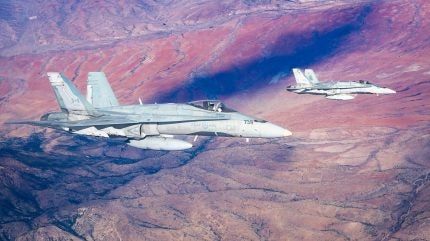
The first six CF-18 Hornet fighters upgraded via the Hornet Extension Project (HEP) have been delivered to the Royal Canadian Air Force (RCAF), marking the programme’s initial operational capability (IOC) milestone.
In a social media post on 8 July 2024, the RCAF stated that the arrival of six operational CF-18s was conducted as part of Phase 2 of the HEP programme, which it said remained on schedule to achieve full operational capability by March 2026.
Canada’s Ministry of National Defense (MND) states that the HEP is intended to ensure that the RCAF’s Hornet fighter fleet is able to meet operational requirements, including integration into the North American Aerospace Defence Command (NORAD) and Nato until 2032, when the permanent fleet of F-35 fifth generation stealth fighters is expected to be fully operational.
The first HEP CF-18 fighter upgraded for the RCAF was delivered in August 2023.
The attainment of the HEP IOC was originally set to be reached by December 2023, with the recent announcement indicating a seven-month delay. Canada’s MND originally stated that FOC will be reached by June 2025, with the RCAF social media post now pointing towards an expected nine-month delay in the programme.

US Tariffs are shifting - will you react or anticipate?
Don’t let policy changes catch you off guard. Stay proactive with real-time data and expert analysis.
By GlobalDataHEP: addressing obsolescence and combat upgrades
The HEP programme is planned to upgrade CF-18 Hornet fighters in service with the RCAF, for an estimated cost of C$1.3bn ($950m) in two parallel phases.
Phase 1 of the HEP is intended to deliver enhancements for up to 88 CF-18 aircraft, focused on addressing civilian air traffic management regulations and meeting allied military interoperability requirements.
Meanwhile, Phase 2 centres on additional combat capability upgrades for 36 CF-18 aircraft.
A 2020 announcement by the US Defence Security Cooperation Agency (DSCA) stated the US State Department had approved the possible Foreign Military Sale of equipment related to Canada’s HEP programme, for an estimated cost of $862.3m.
Included in the equipment was a request from Canada for 50 Sidewinder AIM-9X Block II Tactical missiles; 50 Sidewinder AIM-9X Block II Captive Air Training Missiles; 38 APG-79(V)4 Active Electronically Scanned Array (AESA) radar units; 38 APG-79(V)4 AESA radar A1 kits; 20 Joint Standoff Weapon (JSOW) C, AGM-154C; and 46 F/A-18A wide band RADOMEs.
In providing reasoning, the DSCA stated that the proposed sale would provide Canada “a two-squadron bridge of enhanced F/A-18A aircraft to continue meeting NORAD and Nato commitments while it gradually introduces new advanced aircraft via the Future Fighter Capability Program between 2025 and 2035”.
Canada opts for F-35 to replace CF-18 fighters
The HEP programme is tied closely to the eventual arrival of Canada’s next generation fighter, which finally selected the Lockheed Martin F-35A stealth fighter in January 2023.
Delivery of the first F-35A is predicted to take place in 2026, followed by the arrival of the next six aircraft in 2027 and a further six in 2028, with a final fleet total of 88 F-35 aircraft.
Once delivered, the new fleet is expected to achieve full operational capability between 2032 and 2034, and gradually replace the RCAF’s CF-18 Hornet fleet by the end of 2032.
According to the Canadian Government, the F-35 procurement project, which is estimated to be C$19bn, is the country’s largest investment in the RCAF in the last three decades.



